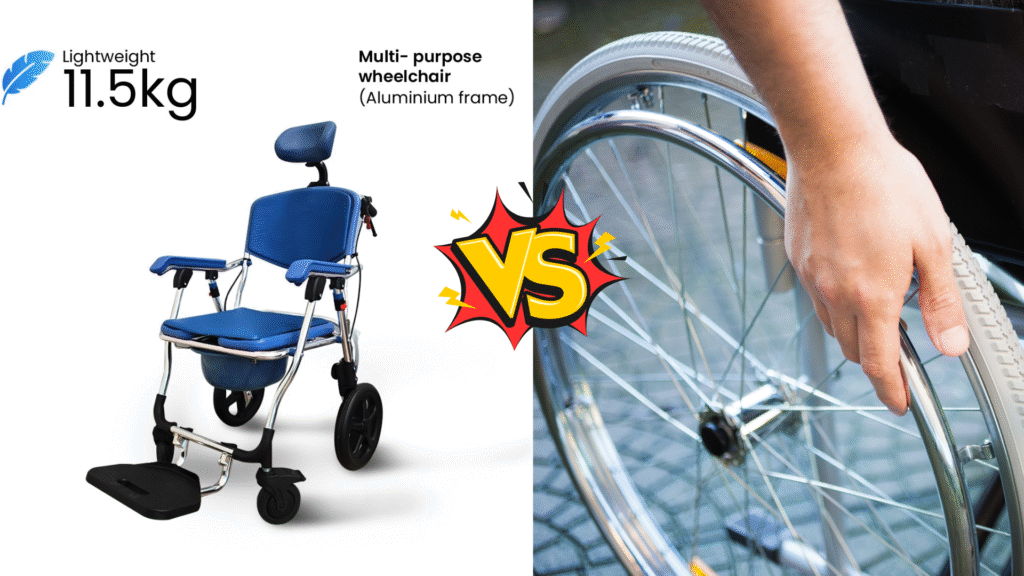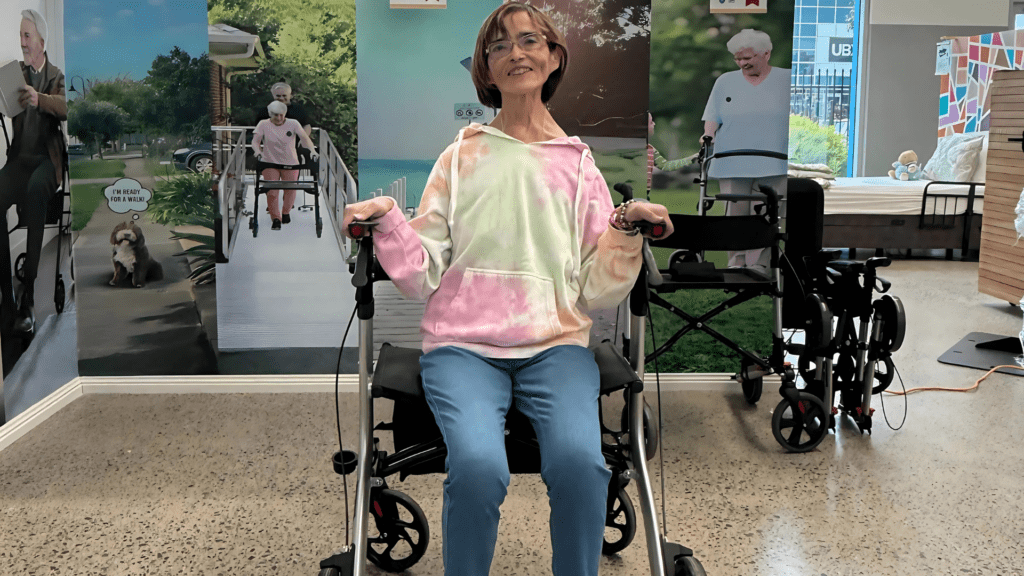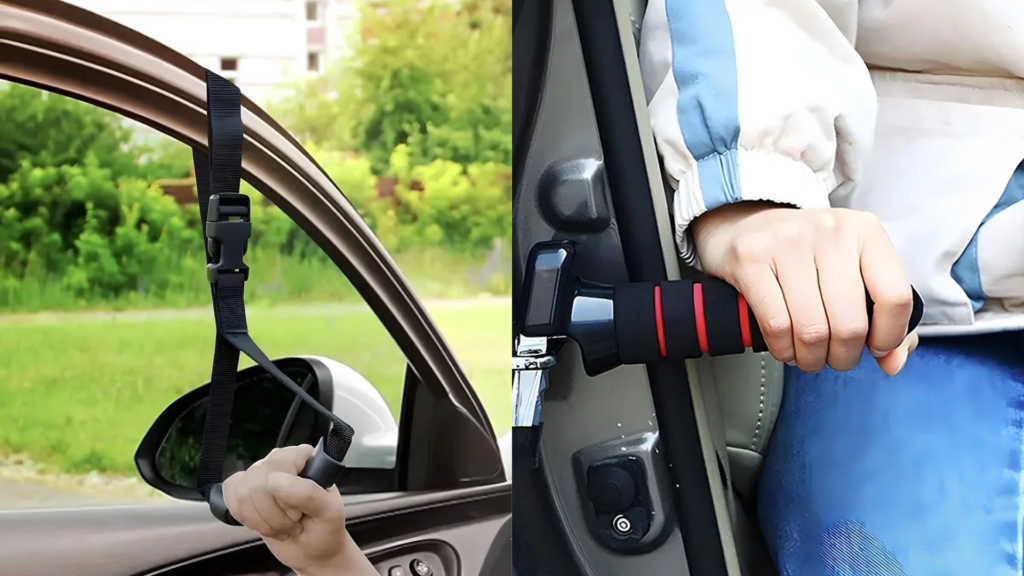Choosing the right commode wheelchair is essential for ensuring safe, comfortable, and dignified toileting and bathing support—whether in a home care environment or aged care setting. Two of the most common types are self-propelled and attendant propelled commode wheelchairs, each designed for different user abilities and care scenarios.
This guide explains the differences between the two types, their use cases, funding considerations, and how to determine the best option for individual or facility needs.
Key Differences Between the Two Types
| Feature | Self-Propelled Commode Wheelchair | Attendant Propelled Commode Wheelchair |
| Rear Wheel Size | Large rear wheels for manual self-propulsion | Small rear wheels for pushing by a carer |
| User Control | User-driven | Carer-driven |
| Independence Level | High – ideal for users with upper body strength | Lower – for users needing assistance |
| Turning Radius | Wider (due to larger wheels) | Tighter – easier in small bathrooms |
| Ideal Users | Independent individuals with mobility support | Frail elderly or people with complex needs |
Benefits of Self-Propelled Commodes
A self propelled commode wheelchair allows the user to move independently while having direct access to toileting and bathing facilities.
Advantages
- Increased independence: Users can move without waiting for a carer
- Enhanced dignity: Promotes self-management of personal hygiene
- Versatile use: Can be used as a transport chair, shower chair, and commode
- NDIS support available: Especially for participants aiming to increase daily living skills
These models are best suited to people with:
- Good upper body control
- Cognitive awareness
- Home settings with wide bathroom access
Browse our foldable self-propelled wheelchair with commode for independent use at home or supported living environments.
Advantages of Attendant-Pushed Designs
An attendant propelled commode wheelchair is designed for carers, support workers, or family members to push and manoeuvre the user. These are particularly useful in shared or smaller bathroom environments.
Advantages
- Better manoeuvrability in tight spaces
- Less physical effort for the user
- Safer transfers and handling by carers
- Foldable and compact designs for storage or travel
Ideal for:
- Frail elderly residents in aged care
- Individuals with limited mobility or cognitive impairment
- Carers who assist with daily hygiene routines
These chairs also reduce the risk of falls and manual handling strain for staff in aged care settings.
Explore commode wheelchair options for shared care use or facility deployment.
Use Cases in Aged Care and Home Settings
Aged Care Facilities
- Attendant propelled commodes are commonly used due to space constraints and varying resident mobility levels.
- Facilities benefit from foldable models that can be cleaned and shared between residents.
Home and Community Care
- Self-propelled commodes are ideal for independent users in single-resident homes.
- Carers may prefer attendant models in homes with narrow doorways or small bathrooms.
Occupational therapists often recommend a trial based on the user’s physical abilities, bathroom layout, and carer availability.
Price, Funding and Portability Considerations
| Factor | Self-Propelled Model | Attendant-Propelled Model |
| Cost | Slightly higher due to large wheels | More budget-friendly |
| Portability | Less compact, bulkier wheels | Lightweight, foldable options available |
| Storage Needs | Requires wider storage space | Easier to store in small areas |
| Maintenance | Rear wheels may require more upkeep | Simple and easy to clean |
For NDIS participants, both types are considered assistive technology and may be funded with proper assessment and justification.
NDIS and SWEP Guidance on Selection
NDIS participants in Victoria can access both self and attendant wheelchair with commode options under their assistive technology funding. An occupational therapist will typically assess:
- The user’s functional capacity
- Environmental access (bathroom layout)
- The role of carers or support workers
- Preference for independence or assisted use
Additionally, the Statewide Equipment Program in Victoria may provide support for interim needs, or where clients are not yet fully on the NDIS.
To begin the process:
- Submit a product enquiry
- Book an occupational therapy assessment
- Request a quote and justification report for submission to your NDIS planner or case manager
Need help navigating the process? Our team at Care With Us can assist with funding pathways and product trials.
Conclusion
Choosing between a self-propelled and attendant propelled commode wheelchair depends on the user’s mobility level, support system, and environment. While self-propelled models offer more independence, attendant-pushed designs provide safety, ease of use, and flexibility for carers and facilities.
- Compare both models in our commode wheelchair collection
- Book a trial or occupational therapy assessment to guide your selection
- Speak to us about NDIS or SWEP support to get the right mobility aid funded and delivered
Frequently Asked Questions (FAQs)
- What is the main difference between a self-propelled and attendant commode wheelchair?
Self-propelled models have large rear wheels the user can push themselves. Attendant models are designed for carers to push. - Which commode wheelchair is better for home use?
If the user is mobile and independent, self-propelled is ideal. If the user needs help or space is tight, attendant-propelled is better. - Does the NDIS cover both types of commode wheelchairs?
Yes. Both models fall under the assistive technology category with proper clinical justification. - Can I fold and store the commode wheelchair easily?
Attendant-propelled commodes are generally more compact and easier to fold. Some self-propelled models are also foldable. - How can I trial a commode wheelchair before buying?
You can request a trial through Care With Us, especially if you’re an NDIS participant or working with an occupational therapist.



